Secondments
My secondment of ten months in the Ondřejov Astronomical
Institute was scheduled as a continuation of my former visit to
the Royal Observatory of Belgium in 2019, where we previously
started to perform spectral fits combining the self-consistent
wind solutions outlined in Gormaz-Matamala et al. (2019) and the
radiative transfer code FASTWIND.
Observed spectra were taken with the HERMES spectrograph, by our
collaborator Dr. Alex Lobel.
This time, the focus was in the improvement of the computational
routines of the code Akd27, which executes the calculation of
our m-CAK line-acceleration self-consistently with the wind
hydrodynamics provided by HYDWIND.
Our efforts were concentrated in the parallelisation to save
computational time, in collaboration with Prof. Michel Curé and
Dr. Jorge Panei.
Also, recent improvements have been incorporated such as
temperature function for the atmosphere directly dependent on
the acceleration of the wind.
During my stay at the Ondřejov Observatory I also had the
opportunity for learning the usage of the Ondřejov ECHELLE
Spectrograph (OES) in the 2m telescope located at the
observatory.
I contributed to the elaboration of a handbook for the OES,
together with Dr. Brankica Kubátová and the PhD student Mauricio
Cabezas.
This job was important for me because it allowed me to get
expertise in the observational side of Astronomy.
However, the most remarkable accomplishment has been the work on
the so-called Lambert-solution for the stellar wind, where we
will have a full NLTE self-consistent hydrodynamics considering
the effects of the clumping.
Self-consistent solutions allow the performance of spectral
analysis with more agreement for theoretical formulations and
with less free parameters.
Solutions for wind parameters under m-CAK leads to reliable
spectral fits which can be used to determine new parameters for
O stars and study evolutive tracks.
Lambert-procedure performs a more complex calculation of
self-consistency, including extra elements such as clumping and
turbulent velocity.
This work has been done using the radiative transfer code
CMFGEN, in collaboration with Prof. D. John Hillier (University
of Pittsburgh, USA) and Prof. Francisco Najarro (Centro
Astrobiología, Spain).
Initially, our Lambert-procedure was thought to be concentrated
for the particular case of zeta-Puppis only, but during this
secondment we extended the analysis into two extra O
supergiants: HD 163758 and alpha-Cam.
Besides, thanks to the help and expertise of Dr. Jiří Kubát and
Dr. Brankica Kubátová, we could expand the discussion about the
sensitivity of the hydrodynamics around the sonic point and
their implications at the moment of accurately constrain the
wind parameters.
Finally, during my secondment I also have the chance to present
my previous work on stellar winds to the Czech experts in the
subject.
For that reason, I did seminars not only at Ondřejov Observatory
but also at Masaryk University in Brno, where I had the
opportunity to exchange experiences with Dr. Jiří Krtička.
Although I had been prepared for a very cold weather, I arrived in the winter season, it was not felt so much, it was almost like a winter in Buenos Aires, the city where I was born. Outside it was cold and windy, inside it was very nice with the heating. Almost every day was rainy, in general with a rain that allows you to move around without using an umbrella, you just need to have waterproof boots and coat. People in the city seem to ignore the rain, they ride their bikes and move around as if it were not raining.
Brussels is very beautiful city; I really liked the architecture and the small artistic details in the buildings.
I enjoyed walking around it. We walked through quiet places, with low buildings (up to 4 floors). We walked through the Centre of the city but also through the neighborhood where we were staying and the way to the Observatory or to the school our daughter attended. I am very grateful to the school, it took in our daughter and incorporated her into one of its courses. They did their best to make her feel comfortable.
The apartment where I stayed was spacious, bright and had all the necessary amenities. We had two neighbors on two upper floors, very nice and a breakfast bar just below where we could have breakfast some day on the weekends.
During the week, Michel and I would leave Sofia at school and go to the Royal Observatory to work.
There I was doing research with Alex Lobel, who provided us with what we needed.
With him I was analyzing the use of wavelet analysis to detect periodicities and in particular, local periodicities. I was very welcome at the observatory; all the colleagues were very nice. I was placed in a large office, at a very comfortable desk. I really liked the work. I reviewed the literature on the use of wavelet analysis in searching for periodicities in light curves with irregular data. I compared methodologies used to date. I analyzed a package made in the R software for wavelet analysis and another made by some Belgians in the Python software. The goal is to find a more efficient algorithm than the ones available until now.
During the weekends we walked around and got to know Brussels.
Besides walking around its streets and neighborhoods, we went to the Atomium, an interesting visit where we could also appreciate a view of the city and the park from above.
We appreciated the beautiful art nouveau architecture in the museum of the instruments, where we could see and hear a lot of instruments. With Sofia we went to the Toy Museum, where she had a lot of fun.
Every day we ate very tasty, something that I have not stopped missing, from sweet foods such as chocolates, croissants, pastries or cakes, to salty: cheese or vegan food, which we cannot find where we live, all exquisite.
We had to return to our country early because of the covid 19 pandemic. However, the time I spent in Brussels was very rewarding, both professionally and in terms of the personal experience I gained from it.
In the frame of this POEMS project, I had a secondment in Brussels, visiting our colleague Dr. Alex Lobel at the Royal Observatory of Belgium.
We started our flight on Jan. 24th 2020 Santiago to Brussels via Heathrow. We depart form a vey sunny day and arrive in the middle of the European winter with -2C in Brussels, Brrr.
We could find a very comfortable flat in the Ixelles quarter, it was a but expensive but it satisfied all our requirements. We also found a school for our 9 year old daughter Sofía, "Ecole de Messidor", where Sofía was warmly received by the Director, teachers and the new school mates, as seen in the next picture. We are eternally grateful to all of them for their hospitality.
Adapting to life in Brussels was very easy, we were able to buy our monthly ticket for public transport and recognise the trams and buses that took us to school and the observatory in a very simple and fast way.
In the observatory the adaptation was also very simple. The group of colleagues at ROB was very nice. There was a common space to have lunch and share with them and the atmosphere was very calm too.
Perhaps the least pleasant activity was going to the supermarket continuously to buy since we did not have a car and the refrigerator in our apartment was very small, so this activity was very frequent and tiring since it had to be done outside of working hours.
During the stay we walked a bit around Brussels and clearly one of the places that we could not miss was the Atomium. The day we visited that place there was a lot of wind and the different sections of the Atomium oscillated a lot, which reminded us of the different earthquakes that we are used to in Chile.
Since I am vegan we dedicate ourselves to looking for good vegan restaurants in Brussels and we found some very good ones, such as the Liu Lin restaurant that is in the center of Brussels. The pictures below show how happy we are having lunch in that restaurant which we visit several times.
Finally the most important thing is that working with Alex was a pleasure, He is a very nice and pleasant person and we were able to have long and interesting conversations on the subject of winds of massive stars. During my stay we managed to find some interesting new results, which we hope to publish in the near future.
Our stay was planned until March 24 but due to the COVID-19 pandemic we had to shorten it for a few days and we returned to Chile on Monday March 16 arriving at our apartment on Tuesday 17 where we were again marvelled of the view of the bay from Valparaíso.
I appreciate the opportunity that this Marie Curie project gave me to visit the Royal Observatory of Belgium and share with these colleagues a very pleasant and productive research stay.
During my stay in the Ondřejov Observatory, Czech Republic, I dedicated
myself to continue the work originally initiated during my stay at the Royal
Observatory of Belgium as a visitor in 2019.
Thanks to the m-CAK prescription performed by us to calculate
self-consistent solutions for hot massive stars (see Gormaz-Matamala et al.
2019), we started a project framed inside POEMS with Dr. Alex Lobel and
Prof. Michel Curé to develop new spectral fitting using the radiative
transfer code FASTWIND and these self-consistent solutions (instead the
commonly used beta-law), for a set of observed spectra taken by Dr. Lobel.
In order to fulfill that achievement, we have proceeded to automatise the
m-CAK procedure and parallelise it.
At the same time, I have established contact with the Theoretical Stellar
Group of Ondřejov headed by Prof. Jiři Kubát and Brankica Kubátová, besides
their colleagues from University of Brno such as Dr. Jiři Krtička.
We have organised some webinars together where I had the chance to show my
doctoral work to the group and received very valuable feedback from
them. Besides, thanks to Dr. Kubátová I have learnt the usage of the Echelle
spectrograph of the 2m telescope of the Ondrejov Observatory.
At the end of January, I gave a talk showing the main results of my
just-finished PhD work to the POEMS's community in Ondřejov Observatory,
headed by Dr. Michaela Kraus.
Finally, I also have continued my previous project of full NLTE
self-consistent stellar winds using the radiative transfer code CMFGEN and
Lambert-function, in collaboration with Prof. D. John Hillier from
University of Pittsburgh (USA) and Dr. Francisco Najarro from Spain. We
expect to submit the respective manuscript within one month.
Wolfgang Glatzel from the Institute for Astrophysics of the University of Göttingen, Germany, visists the National University of La Plata, Argentina (2. Nov - 1. Dec 2019)
The warm welcome and hospitality of staff, colleagues and
students at the observatory of the National University of La Plata
was an outstanding attribute of my visit. Thanks to all of them
for their care and for making my stay a very pleasant experience!
Half of my time was covered by the summer school on
"Pulsations Along Stellar Evolution", where I was responsible
for a part of the lectures on the theory of stellar pulsations.
Highly motivated and interested students together with
highly competent co-lecturers were responsible for making
this school a very successful event.
Apart from the summer school I took the opportunity to discuss
the physics of variability and mass loss in blue supergiants,
yellow hypergiants, LBVs and Wolf-Rayet stars with colleagues
and students at the observatory. The ideas developed will
further theoretical studies on these objects within the
POEMS collaboration.
Within the frame of POEMS, I visited the University of La Plata for a period of seven weeks. I started my collaboration with the group of Prof. Lydia Cidale a decade ago, and since then I regulary travel to La Plata for working visits. Therefore, I knew already the place, as well as the kindness and warmth of the Argentinian people.
During my visit, the Summer School on
"Pulsations Along Stellar Evolution" took place at the campus of the Unversity of La Plata, which had been fully organized by members of the POEMS team. As the chair of the Scientific Organizing Committee, I had the pleasure to open and close the event. Moreover, I was giving two lectures during the School, entitled "Current and future missions" and "Pulsations in evolved massive stars". I also led one exercise, during which the students had to apply the acquired knowledge to real data.
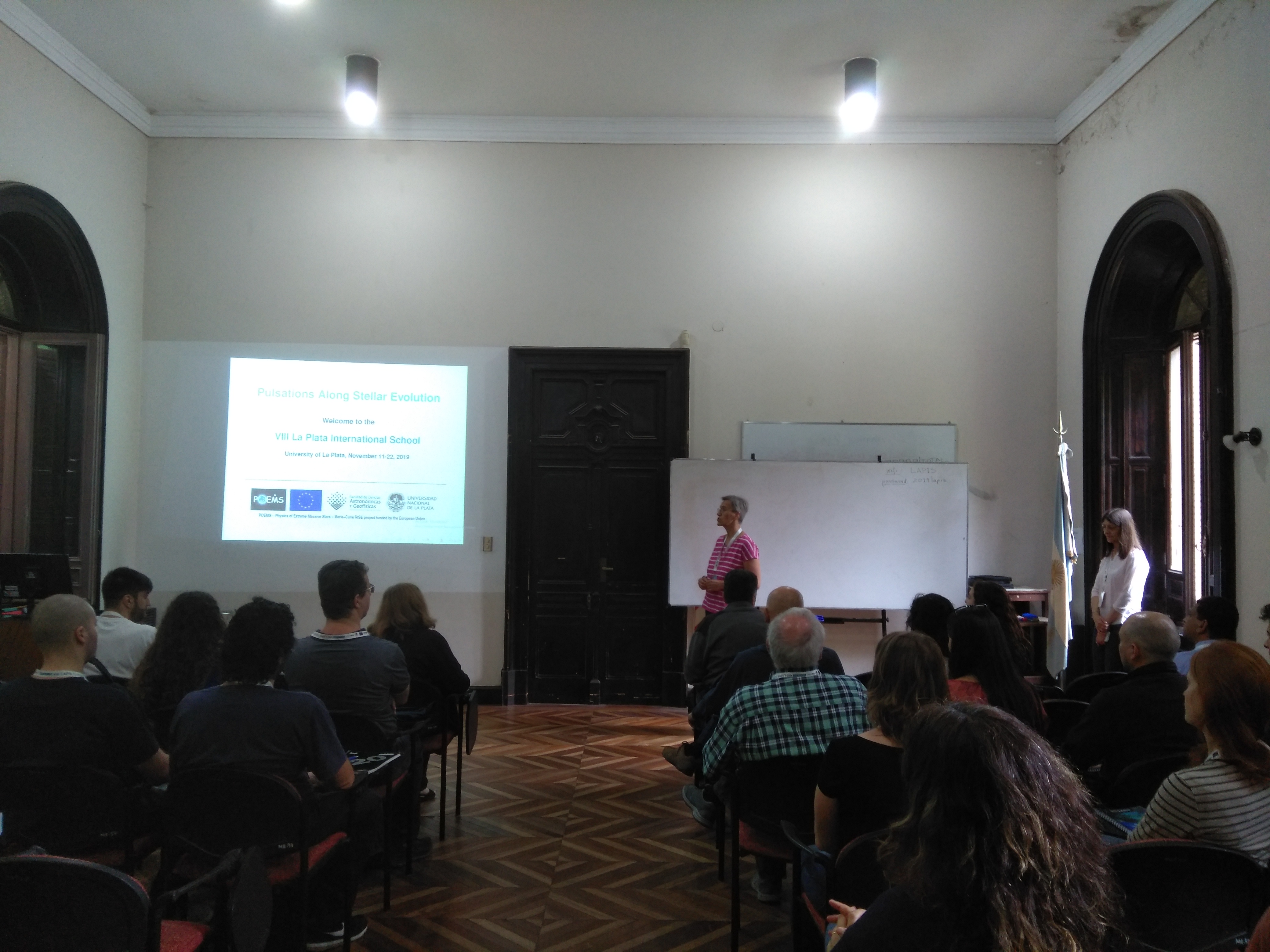
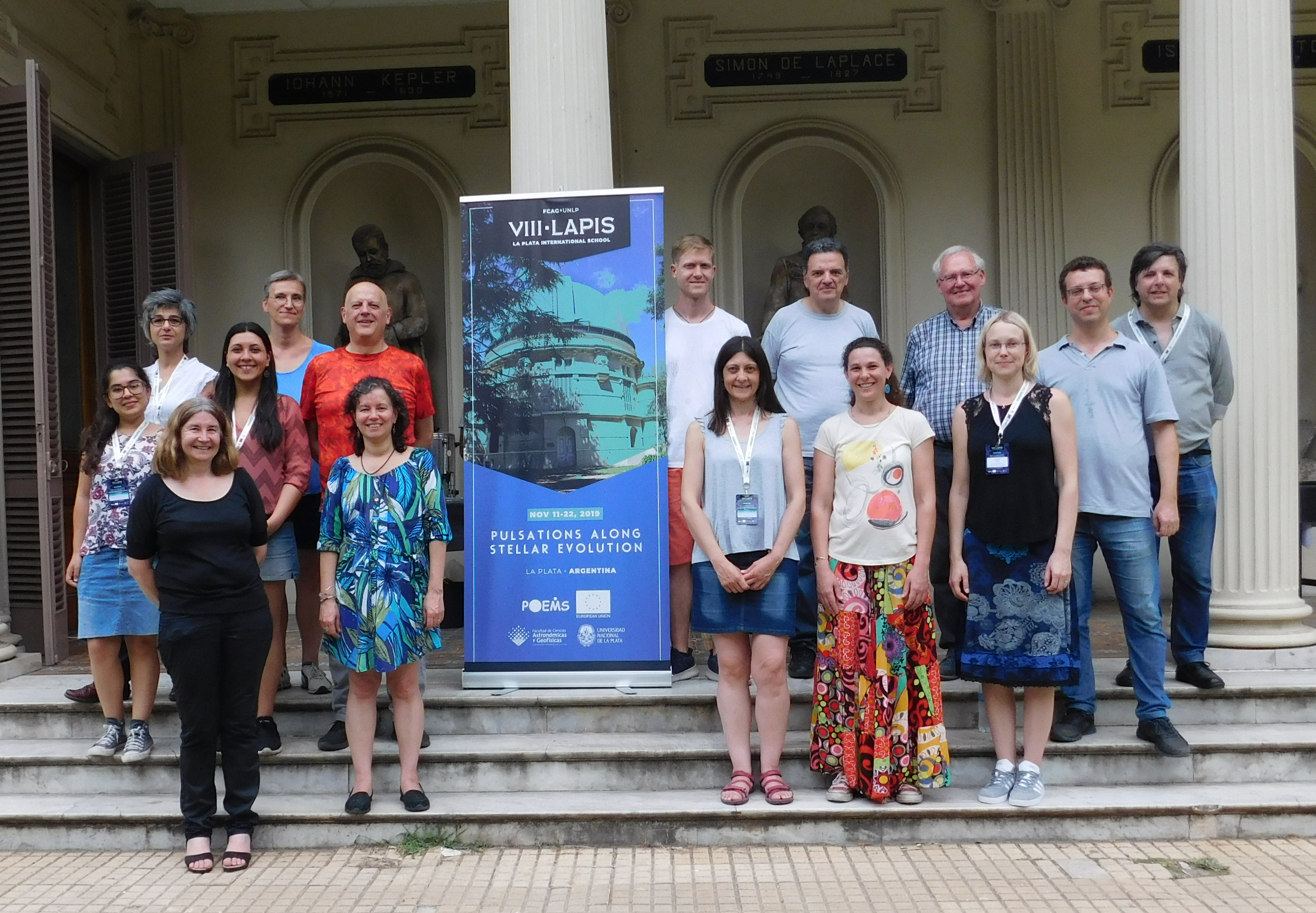
The active participation of many POEMS members during the Summer School and the extended visit to La Plata of some of them beyond the period of the school allowed furthermore detailed discussions with all of them on individual parts of the POEMS project. Some of the discussions, as well as the celebration of the successful completion of the Summer School with the Local Organizing Committee, continued after regular working hours in some of the many nice restaurants, where we enjoyed the national Argentinian kitchen: Asado.
It was a great pleasure to be with so many friends and colleagues, and I look forward to return to La Plata in the near future.
During my visit I have acquainted with the telescopes of Observatory of Tartu University,
participated at the observations. The modern data reduction techniques have been discussed.
Together with the astronomers of Observatory of Tartu University the necessary information were
added to the fits files headers of echelle spectrograms obtained at Shamakhy Astrophysical
Observatory (ShAO) during the year 2019. This was very important for the data reduction by using
IRAF. The database of spectra has been created. We discussed objects for the future joint investigations,
main directions of future research, visits from ShAO to Observatory of Tartu University and vice
versa during 2020.
In addition, I have participated in the following seminars and meetings:
03.10.2019 - Engineer at the UT Tartu Observatory Tiina Liimets PhD thesis defense in physics
„Nebulosities and jets from outbursting evolved stars“.
31.10.2019 – Space community Forum in Tartu Observatory
31.10.2019 - UT Physicum. Senior Research Fellow Jukka Nevalainen talk about X-ray astronomy.
06.11.2019 - astronomy seminar at Tartu Observatory. Maret Einasto presentation “The supercluster
A2142: a textbook example of the evolution of structures in the cosmic web, or the greatest mystery
in the Universe?”.
07.11.2019 - remote sensing seminar in Tõravere. Jan-Peter George presentation “Remote sensing
through a tree breeder's eye: can we solve the ecological crisis in a mutual way?”.
27.11.2019 – Astronomy seminar. Joonas Nattila “Physics of turbulence in magnetically dominated
collisionless plasmas.
27.11.2019 - remote sensing seminar at Tartu Observatory in Tõravere. Mariliis Vaht presentation
entitled "Future UIs: Advances in Intuitive Technologies"
10.12.2019 - the exhibition of NASA images in Tõravere mainly focus on Apollo missions, starting
with Apollo 11, flown to the moon by Neil Armstrong and Buzz Aldrin
12.12.2019 - Astronomy seminar “About an 80-year-old's life” devoted to the celebration of 80 year
birthday of astronomer Tõnu Viik.
20.12.2019 - last astronomy seminar, University of Tartu awarded long-time astronomers: Enn Saar
received the grand medal, Jaan Pelt the small medal, and Urmas Haud the badge of honor.
A. Aret visited UNLP for 3 months (12.09 - 11.12.2019) to learn infrared
observation and data reduction techniques, coordinate joint observing
programme and consolidation of observational data for the unified database.
During the visit she collaborated with M.L. Arias, A. Torres and L.S.
Cidale. Results of spectroscopic study of the sgB[e]-high mass X-ray binary
CI Cam based on infrared spectra from UNLP and optical spectra from UTARTU
were reported at the 61st Annual Meeting of the Astronomical Society of
Argentina (September 16 - 20, 2019, Viedma, Argentina) and prepared for
publication in the proceedings of the conference. A. Aret attended the POEMS
Summer School "Pulsations Along Stellar Evolution" which took place in La
Plata during her visit.
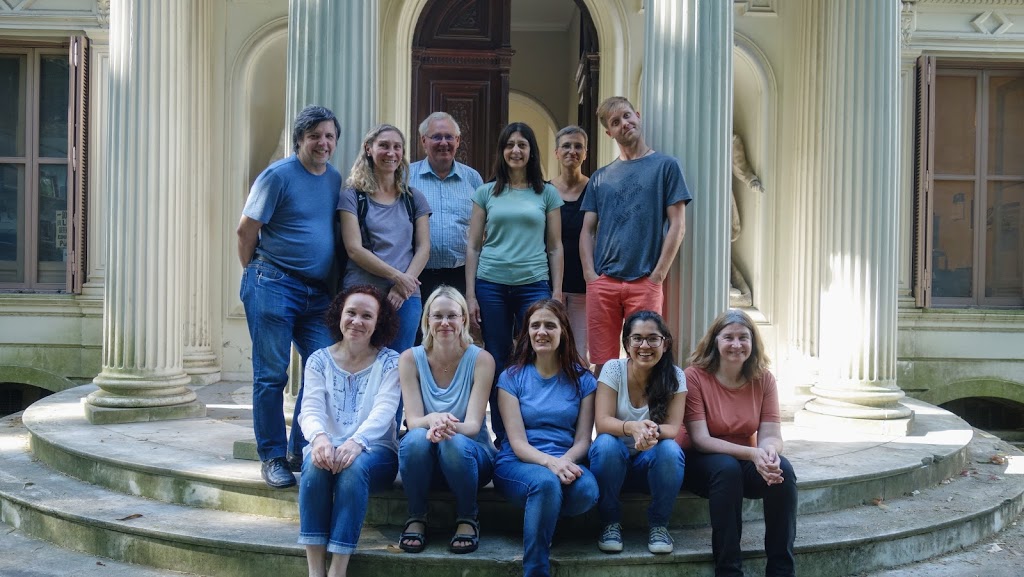
During my one-month stay in Ondřejov, I made progress on my
astrochemical model of discs around massive stars. After being prompted
by Michaela Kraus, I added some options in the hydrodynamical part, considering
purely Keplerian gas orbits in a ring structure, instead of an
outflowing disc. I attended various seminars and gave a talk on
astrochemistry.
I enjoyed the fruitful talks with my office mate Olga
Maryeva on radiation transfer codes, as well as with Brankica Kubátová.
Although Ondřejov is a little isolated, it was possible to go to Prague
after work, and in the weekends I travelled to various cities and sites
of the Czech Republic. I particularly liked Jičín and the Český ráj
(Bohemian Paradise).
– Modeling of the Bracket lines observed in 55 Cyg. The APPEL code was adapted to model NLTE IR H lines formed in an expanding outflow (Cidale & Ringuelet 1993). The implementation of this code was done because the version of the code FastWind that we originally used to model the Halpha line in 55 Cyg (Kraus et al. 2015) presents inconsistent results between the mass-loss rate obtained in the optical and IR regions. After the implementation of the new version of the APPEL code we were able to obtain similar mass-loss rates, showing that it is not necessary to introduce wind clumping to fit IR and optical contemporaneous observations of H lines in the B supergiant 55 Cyg.
– Collaboration in the preparation of a draft manuscript showing the results obtained in the IR region of 55 Cygni. These observations were taken using Gemini instrumental facilities.
– Analysis of the IR color-color relationship of a sample of LBV candidates and discussion about the loci of these stars in the JHK diagram with respect to that of Herbig Ae/B[e] and WR stars. Analysis of reddening effects on the location of the stars in the IR color-color diagram.
– Collaboration in the preparation of a draft manuscript on the study of four emission-line stars: MN83, MN109, MN 109, MN112 stars. Discussion on the results and about new observations to perform.
– Search for new candidates of B[e] and LBV stars to prepare future observing proposals.
– Preparation of a proposal for the Hubble Space Telescope (HST). We submitted our justification and a list of selected emission-line B type-stars in response to the invitation to provide inputs on targets to be observed as part of the ULLYSES program.
– Preparation and organization of the activities related to the School “Pulsations along stellar evolution” in the framework of the POEMS program that would be held in La Plata.
– Seminar Talk given by Lydia Cidale on “Radiation Line-Driven Wind. Theory vs Observations” at the Seminar room of the Stellar Department, ASUS, on September 5, 2019
Abstract: The classical theory of radiatively driven stellar winds often fairly represents the observed stellar wind conditions of massive stars. However, some discrepancies are still found between the parameters predicted by the theory and those observed in mid-B, late-B, and A-type supergiants. Inclusion of rotation and ionization in the models brought a remarkable progress in the development of the theory of stellar winds. Three types of stationary wind regimes are currently known: the classical fast solution, the Omega-slow solution that arises for fast rotators, and the delta-slow solution that takes place in highly ionized winds. I discuss these hydrodynamical solutions in the context of the observed wind properties of B and Be stars.
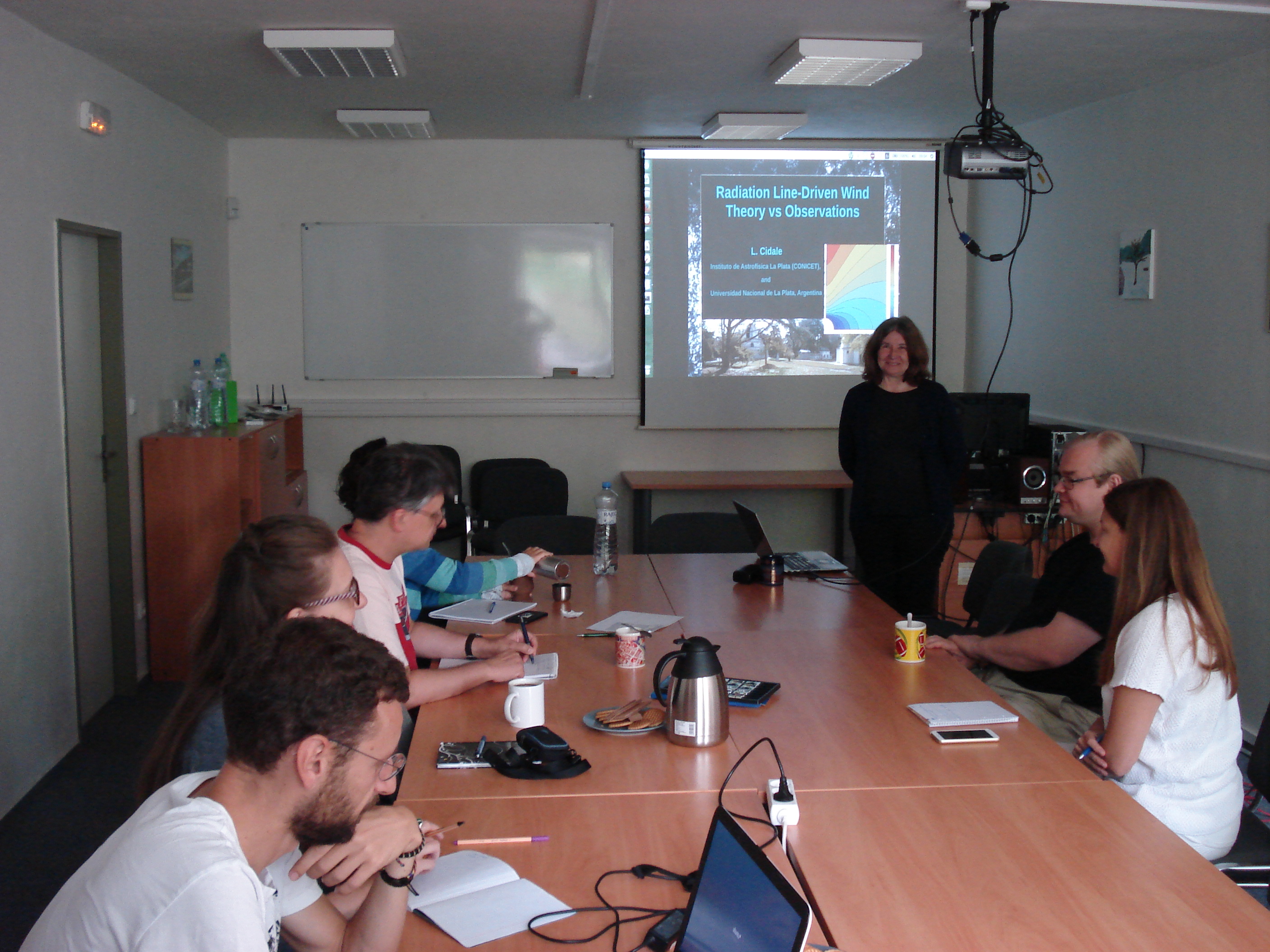
– Discussions with various members of the POEMS project about the activities to be performed during the next months.
I visited the Stellar Department of the Astronomical Institute in
Ondřejov (Czech Republic) for three months.
During my stay, I began working on the study of massive stars in
transition phases with different techniques. A sample of four objects
was selected to analyze spectroscopically and photometrically, in
order to obtain information on the observed circumstellar envelope and
contribute to the determination of its evolutionary state. The
spectroscopic analysis included the study of optical and infrared
spectra, through the identification of the spectral lines present and
fitting models of ionized wind. The photometric analysis included the
determination of magnitudes in the optical range. Also, we studied
color-color graphics with infrared magnitudes available in the
literature.
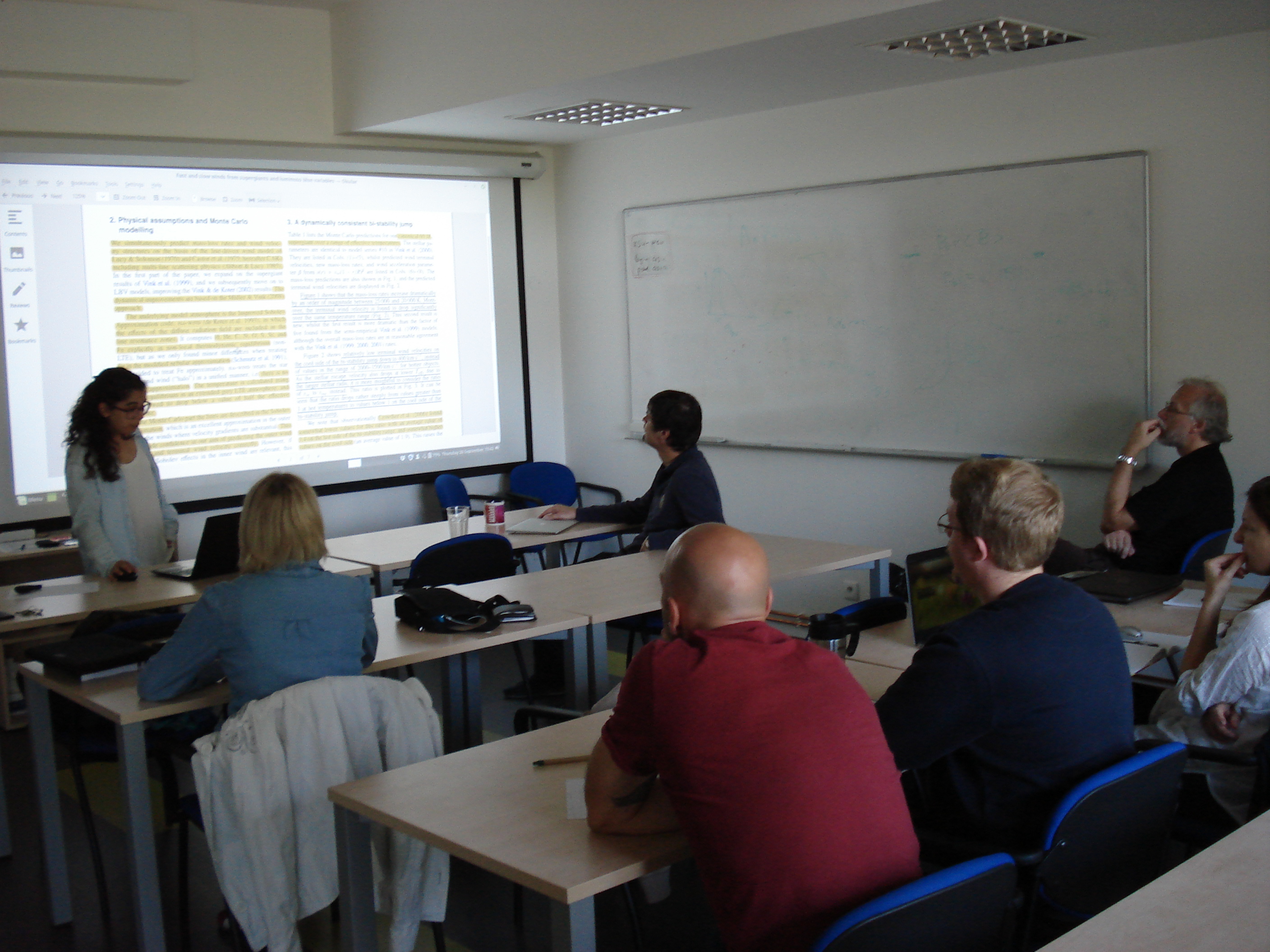
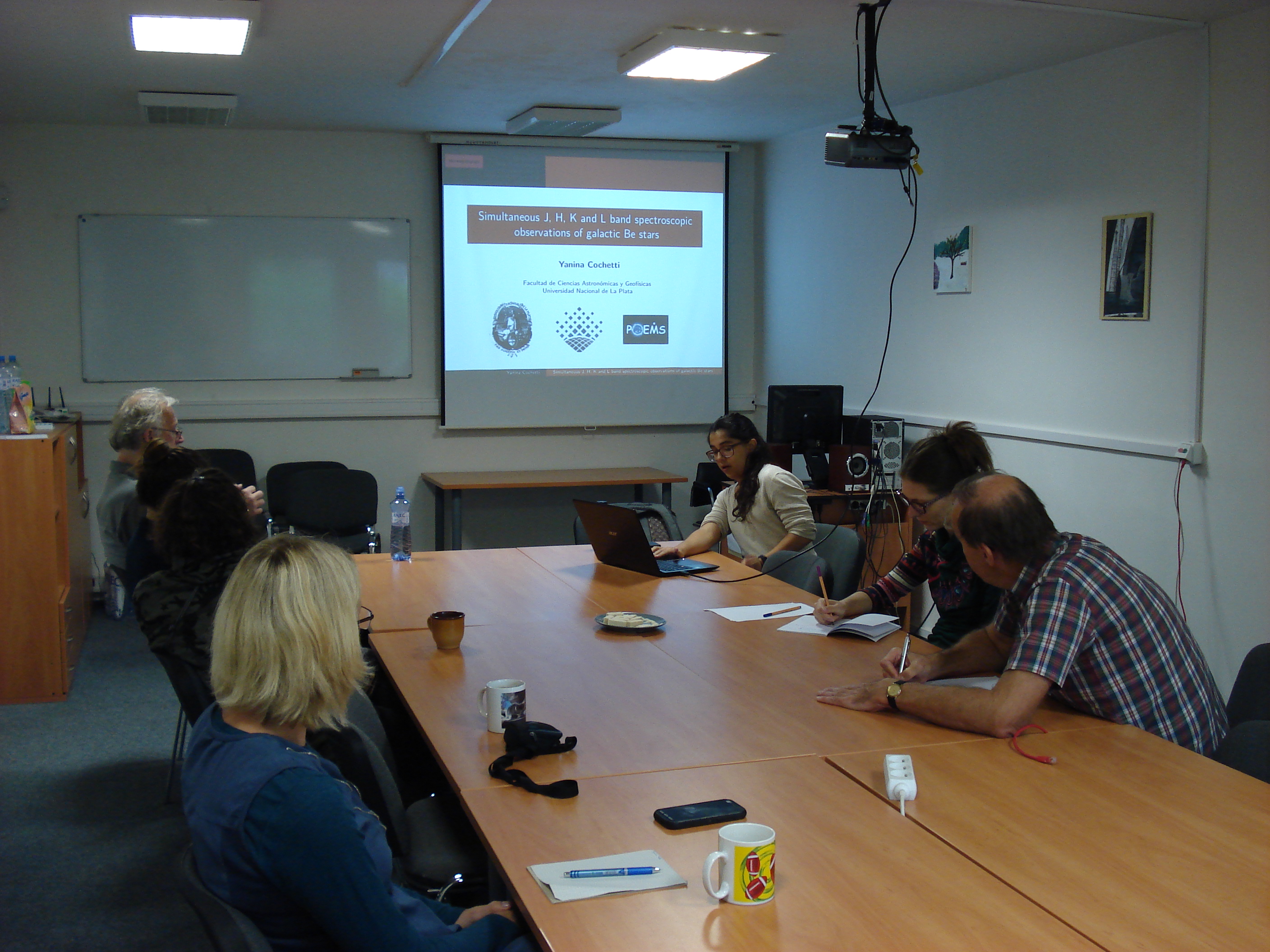
In addition, I participated in an interdepartmental meeting, some
seminars, paper discussion meetings and reunions with other members of
the POEMS project. This allowed me to exchange ideas with other
colleagues and to know their investigation areas. I also gave a
seminar talk about simultaneous J, H, K and L band spectroscopic
observations of galactic Be stars, sharing results of my PhD thesis.
I had a very nice experience working in Ondřejov and I am very
grateful to the members of the Star Department for welcoming me.
I visited to the University of Tartu, Estonia in the period from May 15 to
June 15, 2019 for a scientific research work. Framework Programme for
Research and Innovation Horizon 2020 (2014-2020).
I learned about the processing of spectral materials in the Linux operating
system through the IRAF program for about a month. I intended to start
processing multi-spatial spectra, which was partially mastered by processing
a composite spectrum and acquired by multiplex spectrum.
I participated in the seminar three times. One of them was my seminar. I
participated in this workshop with two topics: "Determination of chemical
composition and parameters of HD 161796 star" and "Processing of spectral
materials in DECH 20, DECH 20T and DECH 30 software packages." During the
period of study, I conducted spectral observations of the WR 134 Wolf-Rayet
type star on the telescope on 09.06.2019 and 15.06.2019.
It was very interesting for me to live in Tõravera. During my visit I have
been at very interesting places. One of them was the Eesti Mermuuseum in Tallin. I
visited this museum because I needed to gather some information for my
uncle who was sailor. The most wonderful things about this museum were its
ancient ships, vessels' wear and the old submarine. In conclusion I want to
write that Estonian people were very friendly and hospitable. The trip was
unforgettable for me.
I visited the Stellar Department of the Astronomical Institute in Ondřejov, Czech Republic from 5. May until 22. of June 2019.
During my research stay I have collaborated with the POEMS team, gave 2 seminars one at Spořilov in Prague on 23rd of May and the other one at the Stellar Department in Ondřejov on 30th of May. Also I have participated in all the group meetings of the POEMS team as well as all the seminars and colloquies of the Stellar department.
The part I found particularly pleasant is that during my stay I shared an office with another POEMS team member from Argentina Rodolfo Vallverdú, so I could make use of this secondment to meet other POEMS member from other Country and exchange our research experiences transversely within POEMS.
The Astronomical Institute in Ondřejov is an excellent place for a research visit as the lodging provided is just a walking distance from the Institute and is isolated from any crowds and noise, such that one can devote all the time to work! While it is close enough to Prague so that one does not get bored over the weekends and is easy to reach from almost everywhere by plane or train.
For two months (24. Apr - 27. Jun 2019), I visited the Stellar Department of the Astronomical Institute in Ondřejov, Czech Republic, to work with Dr. Michaela Kraus. Previously, I was working on the development of a code that allows to calculate the emission spectra corresponding to different diatomic molecules under different conditions of density and temperature, characteristic of circumestellar media.
During my stay, I improved the code to include a disc in Keplerian rotation, in order to obtain an integrated spectrum that takes into account the contributions of all regions of the disk. At this stage we focus on CO and SiO molecules, but at the same time we can model other molecules, such as CS, NH, HCl, SiS, and we plan to include several more.
In addition, thanks to the contributions of Dr. Michaela Kraus, I learned how to use the results obtained to compare them with the observations, which are obtained by different researchers of POEMS, using the telescopes to which the collaboration has access.
Also, my stay was enriching my experience because I could exchange knowledge with other researchers. I gave a seminar about the topics of my present research paper and I was able to attend talks by other POEMS researchers, some belonging to the Astronomical Institute staff and others who were visiting just like me. Thus, I attended seminars by Michaela Kraus, Tiina Liimets, Olga Maryeva and Maja Vučković.
The city of Ondřejov, where the Astronomical Institute is located, is near Prague and is a quiet place, and in particular in the Stellar Department I felt very comfortable with a very good working environment.
My visit was for two months. I have stayed in Tõravere during my visit.
I obtained skills on working with Linux operating system. I have learned contemporary data reduction techniques using IRAF software, acquired necessary skills for reducing data from single slit spectrograph and started to learn reduction steps for echelle spectra. I also explained to my supervisor Anna Aret basic steps of data reduction with DECH software, which we are using for data reduction at Shamakhy Astrophysical Observatory. We discussed parallels between IRAF and DECH.
I participated at observations and I obtained spectra of the Wolf-Rayet star WR134 which I study for my PhD thesis. I reduced the observational data using newly learned data reduction techniques.
I gave a talk about historical overview, current activities and perspectives of Shamakhy Observatory and have participated at several seminars. We had two meetings with the staff
of the Department of Stellar Physics.
I have been at the Old observatory and Historical museum in Tartu and saw the Fraunhofer telescope. Near Tõravere is the smallest and so nice city Elva. I travelled to Tallin and was in Old town and have visited the Maritime Museum. I was also for a one day in Riga, Latvia. During the two months I discovered Estonia for myself. Here is the beautiful country with many lakes and forests and with kind people.
In the frame of POEMS project, I visited three astronomical institutes
in South America.
At La Plata, my main collaborators were Lydia Cidale and Maximiliano
Haucke. My main task was to start preparations of creating POEMS project
database for different types of observational data, including archival
data at different project member institutes. I got good overview of
variety of data at La Plata University, also first database design was
created. I had nice oppurtunity to participate in observations at CASLEO
observatory with Maximiliano Haucke, we had three good observing nights
devoted to time-series observations of blue supergiant stars.
The deadline of observing proposals for Argentinian time for different
telescope facilities was inside my stay at La Plata, I was involved with
preparations for few separate prosals. At least one of those proposals
(nightly photometric monitoring of most interesting blue supergiants)
was successful.
I gave a seminar about using different Virtual Observatory tools for
planning observations.
After 1 month stay at La Plata, I travelled to Valparaiso University,
Chile. There my work started with preparations of observing proposals
for Chilean time on many international observatories. Together with
Catalina Arcos, Michel Cure, and Maja Vuckovic, we prepared a project of
spectroscopic monitoring of large set of blue supergiant stars. That
proposal was successful, time was granted on SARA telescope.
During my stay, I continued development of POEMS observational database,
data layout was agreed with project participants. Additionally, ideas
from BeSOS database were explored and a problem with that prevented
proper usage of BeSOS was fixed.
After working a month at Valparaiso, my last destination was
Observatorio Nacional in Rio de Janeiro, Brazil. I worked there mainly
in cooperation with Marcelo Fernandes Borges. During the visit, I got
good insights about speckle interferometric observations, required data
reduction and it's interpretation. I had there fruitful discussions with
several people, also regarding POEMS database storage questions. It
should be possible to host one instance of the database at National
Observatory. POEMS database development continued. Ideas of future
observational proposals for POEMS project were discussed.
My trip to the Royal Observatory of Belgium in Brussels was my first journey inside the
frame of the POEMS project, and belongs to my first visit at ROB. Second visit is planned to
take place the second semestre of 2019.
During my stay at ROB, I was working with Dr. Alex Lobel, who has a large database
with high-resolution spectra observed with spectrographs such as HERMES, ESPaDOnS plus
others. The main goal of this visit, has been the usage of these high-resolution spectra to extract
stellar and wind parameters for those stars based on our recently performed hydrodynamically
self-consistent solution for stellar winds (see paper of Gormaz-Matamala et al., 2019). That
means, this work with Dr. Lobel will be the first study about features for massive stars using
the prescription previously performed by us, which means that this visit could be laying the
foundations of a very pioneer study.
Thanks to this visit, I gained a lot of experience related with the usage of observational data
(spectra). During the most part of my PhD, I had been working calculating hydrodynamic
structures and checking the influence on different features over the resulting acceleration of the
wind. However, all that big work does not contemplate the handle of data taken by telescopes
or spectrographs, so my understanding about some observational aspects of massive star was
not strong enough. Therefore, this visit helped me to learn more of them, complementing this
knowledge with my more theoretical basis.
As a punctual example, during my conversations with Dr. Lobel I learnt how the shape of a
spectral line is influenced not only by physical features (temperature, composition, magnetic or
rotational effects) of the star or the stellar atmosphere, but also by the resolution of the spectro-
graph used to observe the source. As a consequence then, the prescription originally performed
to calculate self-consistent wind structures was modified in order to take these ”technical” effects
into account. The inclusion of these new considerations, together with the daily work I did
testing how the different changes on the self-consistent stellar parameters (temperature, gravity,
clumping) were affecting the resulting synthetic spectra, allowed me to perform a fast and more
precise recipe to find the best spectral fit.
For the next secondment then, we plan to finish these advances initiated here. Specially,
we expect to present a manuscript showing the new spectral fits under self-consistent m-CAK
solutions, together with a discussion about the implications of the new found stellar and wind
parameters. I am so happy with this project because it has a great potential in my opinion;
using all these observational spectra provided by Dr. Lobel and our self-consistent prescription,
it could be possible to create a catalog with new constrained values for temperatures, radii,
masses and mass-loss rates for a huge set of massive stars.
Living and working in Brussels was a very grateful experience for me, it is a city full of life
and also a place with many historical sites to visit. The working atmosphere inside ROB is
extremely pleasant, so I am very much looking forward to my next time in Belgium.
My trip to Shamakhy Astrophysical Observatory (ShAO) in Azerbaijan was the first journey in frame of POEMS project. Thanks to POEMS I had a possibility to see the observatory I heard about a lot, and to work with the persons I knew only from articles.
During the winter time, most of Observatory staff stays in Baku and works in the office inside Academy of Sciences building. So most of my time I spent living in Baku and going to work to the Academy of Sciences.
The primary goal, which I set for myself, was to teach young scientists of ShAO how to use CMFGEN code. CMFGEN is an open source atmosphere modelling code written by Jonh Hillier in order to model the spectra of a variety of objects – O stars, Wolf-Rayet stars, Luminous Blue Variables, A and B stars, central stars of planetary nebulae, and supernovae. CMFGEN code allows to estimate physical parameters of stellar atmospheres, as well as its chemical abundances. Ten years ago, when I started working on building atmospheric models, I had to study it all by myself. So now I want to help others by sharing my hard earned knowledges and experience. I would like to help young astronomers to get from installing the code to getting first scientific results faster and with less troubles.
During most part of my visit, I worked with Ainur Abdulkerimova. Her scientific interests include evolution of massive stars in binary systems, and large part of her future PhD thesis is an investigation of Wolf-Rayet stars. I tried to show and explain to her all major steps of numerical calculations of stellar atmospheres. Also we discussed possible directions of our future collaboration.
With Dr. Sabina Mammedova we suddenly realized that I may help her with photometric monitioring of Ae-Be Herbig star WW Vul, which she is studying. It is great to find such unexpected points of intersection and possibilities for new collaborations.
In the end of January, together with Prof. Rustamov I went to Pirkuli – a small village formed around Shamakhy Astrophysical Observatory. I saw their 2-m telescope (a twin of our Ondrejov Perek's 2-m telescope), which is in a good state, and is equipped with a fiber-fed echelle spectrograph. The Observatory has a vacuum chamber for mirror coating, and the telescope primary mirror was aluminized several years ago. Both the telescope dome and Observatory main building look nice after recent overhaul. The weather was nice, and I was able to participate in night observations. Moreover I talked a lot with Dr. Khidir Mikailov about the structure of observational spectral data and about creating a joint database for spectra obtained in frame of POEMS project.
During my visit I gave two seminars: “WR stars as final stage of evolution of massive stars” and “Nebulae around evolved massive stars”. Also I participated in a meeting of ShAO young scientists – we talked about scientific carreer development possibilities.
It was very interesting for me to live in Baku, in the city where Asia and Caucasus meet each others and blend together in an unique way. It is also a city where Lev Landau, famous physicist and Nobel prize winner, was born. I was glad to see the house where his family lived and where he grew up. And thanks to Ainur Abdulkerimova and her relatives I visited Shaki – another old Azerbaijanian town, where the signs of historic Caucasian Albany may still be found.